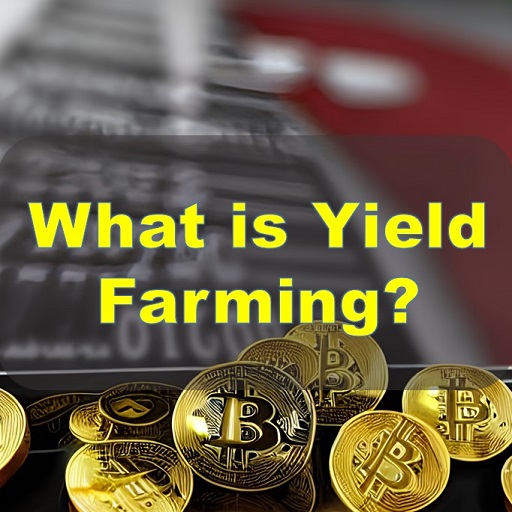Yield farming, also known as liquidity mining, is a practice in decentralized finance (DeFi) where users lock up their cryptocurrencies in smart contracts called liquidity pools. By providing liquidity to these pools, users enable decentralized exchanges or lending platforms to function smoothly.
Yield farming involves lending or staking cryptocurrencies and earning rewards in the form of additional tokens. These rewards are typically generated by the platform’s transaction fees or newly minted tokens. Yield farmers allocate their funds to various liquidity pools or protocols to maximize their earnings.
The process typically involves the following steps:
Selecting a Platform
Yield farmers choose a DeFi platform that offers yield farming opportunities. These platforms can include decentralized exchanges (DEXs), lending platforms, or other DeFi protocols.
Providing Liquidity
Users deposit their desired cryptocurrencies into specific liquidity pools on the chosen platform. These pools require a balanced combination of two or more tokens to ensure market liquidity for trading or lending.
Earning Rewards
In return for providing liquidity, users receive rewards in the form of additional tokens. These rewards are generated through various mechanisms such as transaction fees, yield generated by lending protocols, or newly minted tokens.
Harvesting and Reinvesting
Yield farmers periodically “harvest” their rewards by withdrawing them from the liquidity pools. They can then choose to reinvest these rewards in other pools or platforms to compound their earnings.
The goal of yield farming is to maximize the return on invested capital by seeking out platforms with higher yields or incentives. However, it’s important to note that yield farming carries risks, including impermanent loss (a temporary loss of value due to price volatility), smart contract vulnerabilities, and market risks associated with the underlying assets.
It’s crucial for participants to conduct thorough research, understand the risks involved, and use reputable platforms before engaging in yield farming.
Strategies and Incentives
Yield farm involves various strategies to maximize returns. Platforms may offer different incentives and rewards to attract liquidity providers. These incentives can include additional tokens, governance rights, or a portion of the platform’s transaction fees. Yield farmers often analyze the potential returns, risks, and tokenomics of different platforms to make informed decisions.
Token Swapping
Yield farming often requires users to provide liquidity in the form of token pairs. For example, a popular pair could be Ethereum (ETH) and a stablecoin like DAI. These tokens are locked in a smart contract, allowing users to swap between them when trading occurs on the platform. Yield farmers earn fees generated by these swaps proportional to their share of the liquidity pool.
Automated Market Maker (AMM) Protocols
Many yield farming opportunities are facilitated by AMM protocols, which provide liquidity and enable token swapping without relying on traditional order books. These protocols use mathematical formulas to determine token prices based on the ratio of available tokens in a liquidity pool. Popular AMM protocols include Uniswap, SushiSwap, and PancakeSwap.
Impermanent Loss
One of the risks associated with yield farming is impermanent loss. It occurs when the value of the tokens in a liquidity pool changes significantly compared to when they were initially deposited. If one token appreciates significantly while the other depreciates, liquidity providers may experience a temporary loss when withdrawing their funds. However, over time, this loss can be mitigated or even turned into a profit through earning fees and rewards.
Staking and Farming Tokens
Some platforms require users to stake specific tokens to participate in yield farming. Staking involves locking up tokens for a predetermined period to support network security and decentralization. In return, users receive rewards. These staked tokens are often used as collateral or governance rights within the ecosystem.
Risk and Security
Yield farming carries inherent risks, including smart contract vulnerabilities, hacks, and bugs in the protocols. It’s crucial to assess the security measures implemented by the platforms before participating in yield farming. Audits, code transparency, and the reputation of the project team are important factors to consider.
Gas Fees and Network Congestion
Yield farming often takes place on blockchain networks, such as Ethereum. These networks can experience congestion during periods of high activity, resulting in increased transaction fees or delays. It’s important to consider these factors when evaluating the potential profitability of yield farming.
Diversification and Strategy
Yield farmers often diversify their investments across different platforms, pools, or protocols to spread their risk and maximize potential returns. They may employ different strategies, such as yield optimization tools or automated platforms that allocate funds based on market conditions.
Governance and Voting
Some yield farming opportunities include governance tokens that grant holders voting rights in the platform’s decision-making processes. Yield farmers can actively participate in shaping the future of the protocol by voting on proposals, upgrades, or changes to the platform’s parameters.
Evolving Landscape
The DeFi space, including yield farming, is highly dynamic and rapidly evolving. New platforms, strategies, and innovations regularly emerge. Staying informed about the latest developments, following reputable sources, and engaging with the community can help yield farmers navigate the ever-changing landscape.
Regulatory Considerations
As with any cryptocurrency-related activity, it’s important to be aware of the legal and regulatory implications of participating in yield farming. Regulatory frameworks may vary across jurisdictions, and it’s advisable to seek legal guidance to ensure compliance with local laws.
Yield farming has gained popularity due to its potential for high returns in the rapidly evolving DeFi space. However, it’s important to approach yield farming with caution and conduct thorough research to understand the risks, platform security, and potential returns associated with each opportunity.
Remember that yield farming involves financial risks, and it’s crucial to do your own research, understand the platforms and protocols you are using, and exercise caution when allocating your funds.
How yield farming works?
Yield farming, also known as liquidity mining, works by providing liquidity to decentralized finance (DeFi) platforms in exchange for rewards. Here’s a step-by-step explanation of how yield farming typically works:
Select a Platform
Choose a DeFi platform that offers yield farming opportunities. These platforms can include decentralized exchanges (DEXs), lending platforms, or other DeFi protocols. It’s important to research and select platforms based on factors like reputation, security, potential returns, and tokenomics.
Provide Liquidity
Once you’ve chosen a platform, you need to provide liquidity by depositing your desired cryptocurrencies into specific liquidity pools. These pools require a balanced combination of two or more tokens to ensure market liquidity. For example, you might deposit Ethereum (ETH) and a stablecoin like DAI into a liquidity pool.
Receive LP Tokens
In return for providing liquidity, you receive LP (Liquidity Provider) tokens. These tokens represent your share of the liquidity pool and serve as proof of your contribution. LP tokens are often specific to the platform you’re using and can be traded or used to redeem your share of the pool.
Earn Rewards
As users trade, borrow, or lend assets on the platform, transaction fees are generated. Yield farming platforms distribute a portion of these fees to liquidity providers as rewards. Additionally, some platforms may issue new tokens as rewards, either to incentivize liquidity provision or distribute protocol fees. These rewards are typically proportional to the amount of liquidity you’ve provided.
Harvest Rewards
Periodically, you can “harvest” your rewards by withdrawing them from the liquidity pool. This process involves redeeming your LP tokens for the underlying assets and the accrued rewards. Harvesting can be done manually or automatically, depending on the platform. After harvesting, you can choose to reinvest your rewards in other pools or platforms to compound your earnings.
Monitor and Optimize
Yield farming requires active monitoring to assess the performance of your investments. Keep track of your returns, evaluate the risks, and adjust your strategy accordingly. Some farmers use tools or platforms that help optimize yield farming strategies by automatically reallocating funds to maximize returns.
It’s important to note that yield farming involves risks, such as impermanent loss (temporary loss due to token price volatility), smart contract vulnerabilities, and market risks associated with the underlying assets. Thorough research, understanding the risks, and using reputable platforms are crucial when participating in yield farming.
How the concept of yield farming came about
The concept of yield farming emerged as a result of the evolution of decentralized finance (DeFi) and the desire to maximize returns on cryptocurrency holdings. While the term “yield farming” gained popularity in 2020, the underlying principles and practices have been developing within the DeFi ecosystem for some time.
The rise of decentralized exchanges (DEXs) and lending platforms in the DeFi space provided opportunities for individuals to contribute liquidity to these platforms and earn rewards in return. Early examples of yield farming can be traced back to lending protocols like Compound, which introduced the concept of liquidity mining. Compound’s COMP token incentivized users to lend and borrow assets on the platform by distributing COMP tokens to liquidity providers and borrowers.
The introduction of liquidity pools and automated market makers (AMMs), such as Uniswap, further expanded the possibilities for yield farming. Liquidity providers could contribute assets to these pools and earn a share of the trading fees generated by the platform. As more DeFi projects emerged, they started incentivizing liquidity provision through additional token rewards, creating a competitive landscape for yield farming opportunities.
The concept of yield farming gained significant attention during the DeFi summer of 2020 when several projects launched yield farming campaigns with generous token rewards. These campaigns attracted users seeking high returns and spurred a frenzy of activity in the DeFi space. Since then, yield farming has become a popular strategy for crypto enthusiasts and investors looking to earn passive income or maximize their returns in the volatile cryptocurrency market.
The development of yield farming has been driven by the innovative and experimental nature of the DeFi community. Participants continuously explore new ways to incentivize liquidity provision, optimize strategies, and create more efficient and rewarding systems. This has led to the proliferation of new protocols, platforms, and mechanisms within the yield farming ecosystem.
It’s worth noting that yield farming is an ever-evolving concept, and new variations and approaches continue to emerge. The community-driven nature of the DeFi space, coupled with the desire for financial innovation and maximizing returns, has been instrumental in shaping and refining the concept of yield farming.
Benefits of yield farming
Yield farming, or liquidity mining, in decentralized finance (DeFi) can offer several benefits to participants. Here are some of the key benefits:
High Potential Returns
Yield farming has the potential to generate high returns on invested capital. By providing liquidity to DeFi platforms, participants can earn rewards in the form of additional tokens, transaction fees, or other incentives. Depending on market conditions and the popularity of the platform, these rewards can be significantly higher than traditional financial instruments.
Passive Income Generation
Yield farming allows participants to earn passive income from their cryptocurrency holdings. Once liquidity is provided to a platform, participants can earn continuous returns without actively managing their assets. This passive income stream can be particularly attractive for individuals looking to generate income from their crypto assets without extensive effort.
Portfolio Diversification
Engaging in yield farming provides an opportunity to diversify cryptocurrency holdings. Participants can allocate their assets to different pools, protocols, or platforms, spreading their risk across various projects. This diversification can help reduce the potential impact of any single project’s failure and provide exposure to different sectors within the DeFi ecosystem.
Early Access to Tokens
Yield farming often involves participating in the early stages of new token projects. Platforms distribute their native tokens as rewards to liquidity providers, giving participants early access to these tokens before they are widely available. If the project succeeds and the token appreciates in value, participants can benefit from potential price appreciation.
Governance and Influence
Some yield farming opportunities offer governance tokens, granting participants voting rights and influence over protocol decisions. Participants can actively participate in shaping the future development and direction of a platform. This allows them to contribute to governance, propose and vote on protocol changes, and potentially impact the project’s long-term success.
Learning and Exposure to DeFi
Yield farming provides an opportunity to gain exposure to the decentralized finance ecosystem and its innovations. Participants can explore different platforms, protocols, and strategies, keeping up with the latest developments and trends. This exposure allows individuals to broaden their knowledge, discover new investment opportunities, and potentially identify emerging trends or projects.
It’s important to note that yield farming also carries risks, including impermanent loss, smart contract vulnerabilities, market volatility, and platform-specific risks. Participants should conduct thorough research, understand the risks involved, and exercise caution when engaging in yield farming activities.







